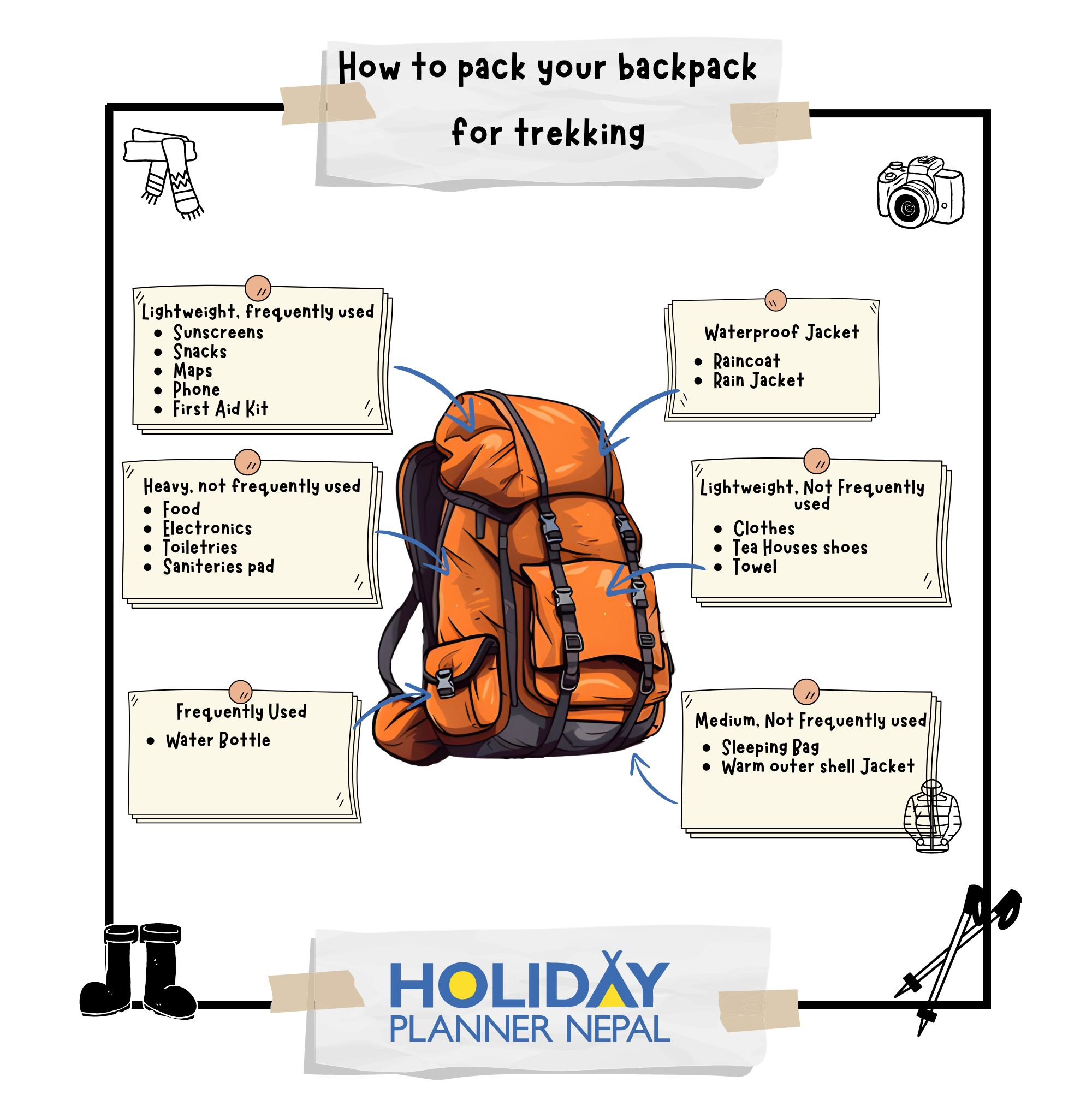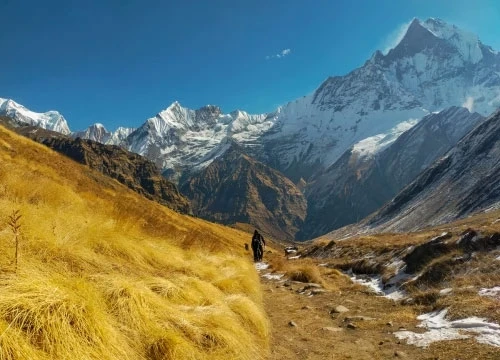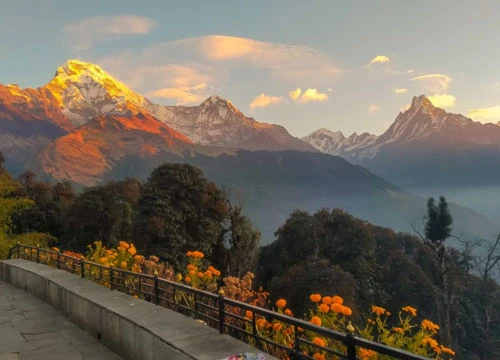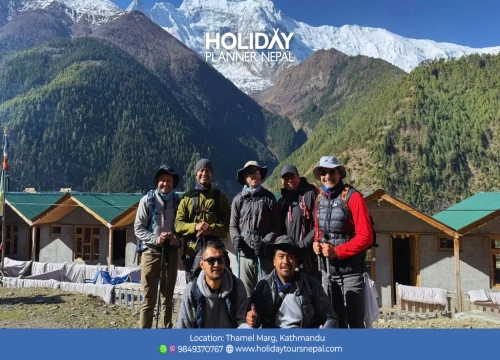Annapurna Base Camp Trekking combined with the Ghorepani Poon Hill Trek is a perfect blend to start your trekking experience in Nepal by getting acclimatized slowly and then heading towards the Annapurna Base Camp.
Why Choose Annapurna Base Camp Trekking in Nepal?
A high mountain valley in Nepal's Himalayas is home to the Annapurna Base Camp, often called the Annapurna Sanctuary. The trek is perfect for all types of travelers and trekkers, as the acclamation is done slowly as we ascend toward the base camp. The Annapurna Base Camp trek is ideal for beginners and first-time trekkers in Nepal.
The Annapurna Base Camp Trekking package combines the Ghorepani Poon Hill trek at Machhapuchhre Base Camp and the Annapurna Base Camp. The views of the Annapurna Mountain Range, including Annapurna South, Annapurna I, Hiunchuli, Gangapurna, and Fishtail, are stunning from the Annapurna Base Camp.
Various civilizations, including Gurung, Thakali, and Magar, are in the Annapurna Region. As you stroll across the area, you can discover more about these people's distinctive customs and way of life.
Various plant and animal species, including rhododendrons, bamboo forests, and the threatened snow leopard, are found in the Annapurna region. Many Hindus regard the Annapurna Base Camp as sacred because they think the goddess Annapurna lives there.
The Annapurna Region provides chances for rock climbing, paragliding, mountain riding, and trekking. Overall, the Annapurna Base Camp is a stunning and culturally diverse area that offers tourists various experiences.
Highlights of Annapurna Base Camp Trekking
- Get ready to walk among the shadows of the massive Annapurna Himalayas.
- An experience to see the Annapurna range Dhaulagiri Tukuche peak Gangapurna Machhapuchhre Hiunchuli Lamjung Himal Manaslu.
- A combination of Ghorepani Poon Hill for sunrise, Machhapuchhre, the Fishtail Mountain Base Camp, and Annapurna Base Camp makes for a perfect trek that makes travelers more than happy.
- One of the oldest trekking routes in Nepal, which is very popular and perfect for beginners and first-time trekkers since it is easy to reach compared to other trekking spots in Nepal.
- One of Nepal's most popular trekking destinations is combined with Ghorepani Poon Hill to witness the once-in-a-lifetime sunrise view.
- Trekking along dense forest followed by sub-alpine forest, which takes us deep inside nature.
- It provides a sense of accomplishment and makes travelers and trekkers realize how basic life can be and how we can live accordingly.
Some Key Points of Annapurna Base Camp Trek
Total Duration: 14 Days
Trek Region: Annapurna Sanctuary, Western Nepal
Maximum Elevation: Annapurna Base Camp – 4,130 m / 13,549 ft
Trek Difficulty: Moderate
Starting Point: Nayapul (after a drive from Pokhara)
Ending Point: Pokhara
Best Trekking Seasons: Spring (March–May) and Autumn (September–November)
Major Highlights:
Sunrise hike to Poon Hill with panoramic views of Dhaulagiri, Annapurna, and Machhapuchhre
Visit to Annapurna Base Camp, nestled within a natural amphitheater of towering Himalayan peaks
Exploration of charming Gurung villages like Ghorepani, Chomrong, and Ghandruk region
Soothing natural hot springs at Jhinu Danda
Lush forests of rhododendrons, bamboo, and alpine vegetation
Acclimatization: Naturally gained with gradual altitude ascent
Transportation: Overland drive between Kathmandu–Pokhara or optional flight
Accommodation: Teahouses/lodges during trek
Trek Ends With: Scenic drive/fly back to Kathmandu
How does the Annapurna Base Camp Trek Begin and End?
Annapurna Base Camp Trekking begins in the well-known tourist destination of Pokhara, which is blessed with the natural beauty of lakes and mountains and passes through the traditional and cultural hill tribal communities of the Gurung and Magar-Poon before crossing the mid-hills of Tikhedhunga and Ulleri before reaching the village of Ghorepani.
One of the biggest trek days is to hike to Poon Hill for the best sunrise view in Nepal, as the mountains start to turn gold as the sun sparks the first beam of light. Gosh, that feeling.
After completing the sunrise view, we returned to Ghorepani, had breakfast, and started our walk toward Tadapani. From here, we can see a clear view of the Machhapuchhre fishtail. From Tadapani, we head towards the village of Chomrong, also known as the land of brave warriors. Then, heading towards Dovan and crossing Bamboo to reach Machhapuchhre Base Camp, the big day awaits the day for going to Annapurna Base Camp. From Annapurna Base Camp, we return to Bamboo, where we turn towards the Jinu Danda, popular as the Jhinu village, and have a good dip at the hot springs. After Jhinu, we hit the road and drove back towards Pokhara.
The hike takes us through Ghorepani Poon Hill, Machhapuchhre Base Camp, and Annapurna Base Camp.
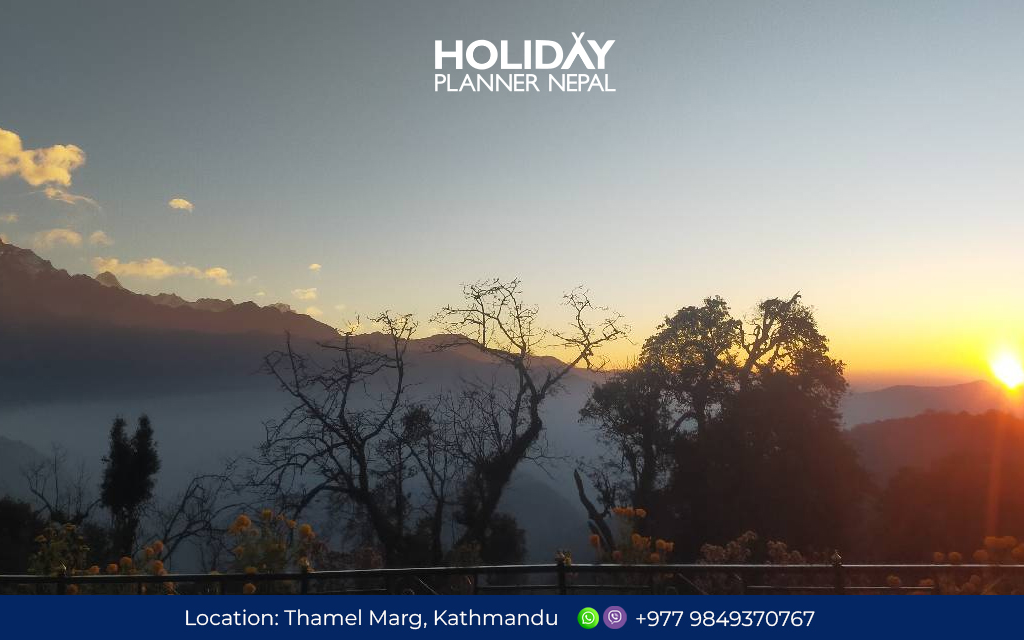
Annapurna Base Camp Trekking: 14 Days Altitude and Distance Coverage
Day | Activity | Altitude (m/ft) | Distance (km/miles) | Duration (hours) | Elevation Gain/Loss |
01 | Arrival in Kathmandu and transfer to the hotel. Evening welcome dinner and briefing session. | 1,350 m / 4,430 ft | ~10 km / 6.2 miles (drive) | ~1-2 hrs (transfers + briefing) | — |
02 | Drive to Pokhara via Nepal-Midwest Highway | 860 m / 2,822 ft | ~200 km / 124 miles (drive) | ~7-8 hrs (drive) | -490 m / -1,608 ft |
03 | Drive to Nayapul and trek to Tikhedhunga | 1,577 m / 5,173 ft | ~11 km / 6.8 miles | ~4 hrs (trek) | +717 m / +2,352 ft |
04 | Trek from Tikhedhunga to Ghorepani | 2,840 m / 9,317 ft | ~12 km / 7.5 miles | ~5 hrs (trek) | +1,263 m / +4,143 ft |
05 | Sunrise hike to Poon Hill and trek to Tadapani | 3,210 m / 10,531 ft | ~14 km / 8.7 miles | ~6 hrs (total) | +370 m / +1,214 ft |
06 | Trek from Tadapani to Chomrong | 2,340 m / 7,677 ft | ~10 km / 6.2 miles | ~5 hrs (trek) | -360 m / -1,181 ft |
07 | Trek from Chomrong to Dovan | 2,630 m / 8,628 ft | ~11 km / 6.8 miles | ~6 hrs (trek) | +290 m / +951 ft |
08 | Trek from Dovan to Machhapuchhre Base Camp (MBC) | 3,700 m / 12,139 ft | ~9 km / 5.6 miles | ~4 hrs (trek) | +1,070 m / +3,511 ft |
09 | Trek from MBC to Annapurna Base Camp (ABC) | 4,130 m / 13,549 ft | ~3 km / 1.9 miles | ~3 hrs (trek) | +430 m / +1,410 ft |
10 | Trek from ABC to Bamboo | 2,345 m / 7,693 ft | ~16 km / 9.9 miles | ~6-7 hrs (trek) | -1,785 m / -5,856 ft |
11 | Trek from Bamboo to Jhinu Village (Hot Spring) | 1,780 m / 5,839 ft | ~10 km / 6.2 miles | ~6 hrs (trek) | -565 m / -1,854 ft |
12 | Trek from Jhinu to road head and drive to Pokhara | 820 m / 2,690 ft | ~5 km / 3.1 miles (walk) | ~1 hr (walk) | -960 m / -3,150 ft |
13 | Drive or fly back to Kathmandu | 1,350 m / 4,430 ft | ~200 km / 124 miles (drive) | ~6-7 hrs (drive) | +530 m / +1,739 ft |
14 | Final international departure from Nepal | — | — | — | — |
How to know if Annapurna Base Camp trek suits you?
Your hobbies, level of physical fitness, and travel preferences will determine whether or not a journey to the Annapurna Base Camp is suitable for you. Here are some things to think about:
Moderate physical fitness is required because the Annapurna Base Camp is located at a high altitude. The route there entails hiking across tough, rocky terrain. Although people of all fitness levels can complete the walk, you should be in decent physical shape.
- Personal Interests: A trip to the Annapurna Base Camp can be a good fit for you if you like to hike, take in the scenery of the mountains, and discover other cultures. The area offers a wide choice of experiences and activities, such as paragliding, mountain biking, trekking, rock climbing, and the chance to learn about the customs and culture of the area.
- Style of travel: Because the Annapurna region is farther away and less developed than other parts of Nepal, there may be fewer modern conveniences and amenities there than elsewhere. A journey to the Annapurna Base Camp can be a good choice if you are accustomed to more basic travel experiences and accept cultural variances.
In conclusion, visiting the Annapurna Base Camp can be gratifying and unforgettable. Still, it's vital to carefully examine whether it's the best choice for you, given your hobbies and physical capabilities.
What is the best time to trek Annapurna Base Camp?
March-May.
The best weather conditions generally occur in March, April, and May. During the summer, it gets warm in the lower elevations. However, they grow more helpful for the voyage as you advance. It will be bursting with petals due to the beautiful rhododendron woodland surrounding the Annapurna Base Camp Trail.
September–November.
The best time to view breathtaking vistas is during these three months (September, October, and November). The climate is Although it's cold in November, the views are stunning.
For a journey to Annapurna Base Camp, the best months to visit are September, October, and November. September and October are festival months in Nepal. The trek to Annapurna Base Camp will be more exciting in October because you can participate in the festivals.
In December and January, the temperature drops, and it gets cold. With its snowy landscape and breathtaking Himalayan beauty, if you plan to trek to Annapurna Base Camp during December and January, Get ready to endure the chilly conditions during these months.
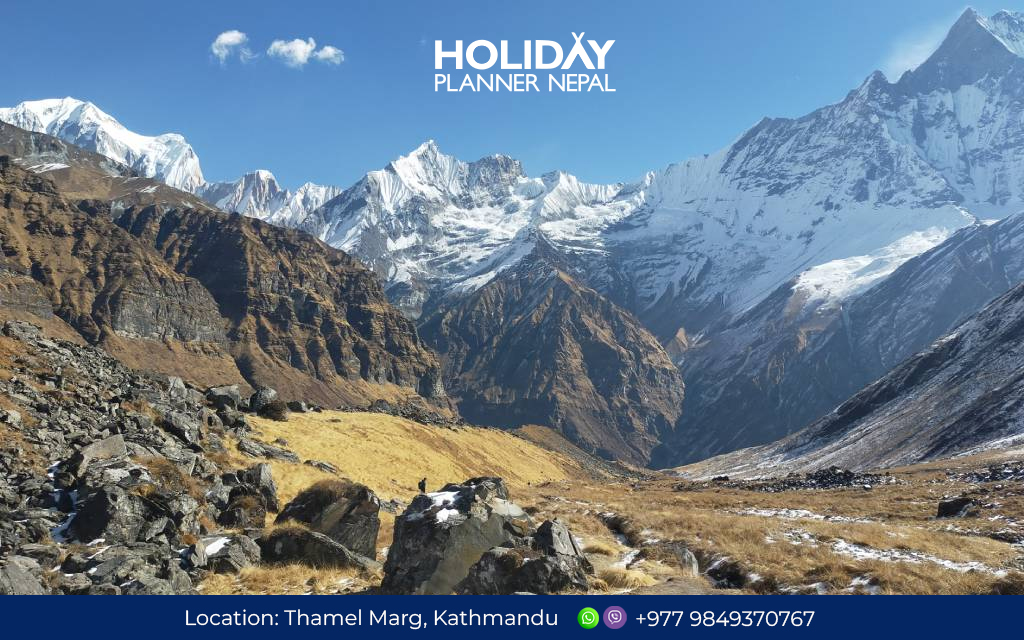
Local culture and tradition around Annapurna Base Camp
Magars are the indigenous population in the Annapurna Region. They adhere to the caste system and are predominately Hindu.
Hindus, who think that the goddess Annapurna lives in the area, attach spiritual significance to the Annapurna Base Camp and the region's diversity of cultures. Numerous Hindu pilgrims travel yearly to the base camp because it is revered as sacred.
There are opportunities to communicate with various ethnic groups throughout the Annapurna Base Camp Trek. At lower altitudes, the Chhetris and Brahmans reside. Gurung and Magar, however, live at higher altitudes. Both of these ethnic groups are significant in Nepal. Another related characteristic we can witness among the region's people is the brave Gorkha instinct in them. The Gorkhas are a well-known military unit recognized for their bravery. On this journey, you will experience the way of life that created these renowned warriors. You can also taste it at one of their houses or homestays.
Accommodation around Annapurna Base Camp
- Tea houses: The Annapurna region has several houses that provide fresh and good dining choices. These tea houses are basic and provide services like Internet, hot showers, good food, and basic facilities.
- Guesthouses on a budget: The Annapurna Region is home to many guesthouses on a budget that provides basic lodging at a lesser cost. These lodgings may be less handy for reaching the base camp and frequently have communal facilities and few amenities.
- Homestays: Another option for accommodation in the Annapurna Region is a homestay, where you can stay with a local family and experience authentic Nepali culture. Homestays can be a great way to immerse yourself in the local community and learn more about the region's culture and traditions.
Foods available at Annapurna Base Camp?
Holiday Tours Nepal arranges the nicest local lodges throughout the Annapurna region of this hike, from the start to the finish. The lodge's comprehensive menu features everything from the famous Nepalese Dal-Bhat to Continental fare and some Chinese, Tibetan, and Indian dishes, delicious meals based on your tastes. Every meal is properly prepared, presented in a sizable bowl, and cleaned. An eating establishment with a warm environment.
Acclimatization at Annapurna Base Camp
The Annapurna Base Camp Trek requires adapting to the environment, including the weather, climate, traditions, cultures, and cuisine. During customs planning, the routes always remember that we shouldn't ascend more than 1000 meters daily.
Altitude Sickness and respiratory problems may result from a rapid rise in altitude. On the other side, slowing down and stopping occasionally along the way allows our bodies to react to changes in climate, weather, and temperature.
Some foods and drinks must occasionally be avoided, like caffeine, meat, and other things that are hard for our stomachs to digest. Since they cause physical and psychological tension, leading to digestion issues, headaches, irritability, mistreatment, and a lack of services.
Travelers should always provide prior notice to Holiday Tour Nepal and mention the foods and beverages they are allergic to or do not consume when asking about the available foods and drinks before embarking on a cruise, as this will help formulate a plan for food and beverages.
Permits cost for Annapurna Base Camp Trek
Nationality | Annapurna Conservation area | Tims Card | Apply for permits now |
Indian citizens | Rs 1500 | Rs 1000 | Apply for permits |
Foreign citizens | Rs 3000 | Rs 2000 | Apply for permits |
Nepali citizens | Rs 100 | Rs 100 | Apply for permits |
Note: Children’s below 8 years don’t require permits.
Where to get the permits for Annapurna base camp?
Annapurna conservation area permit can be obtained at Kathmandu and Pokhara. Tims card is issued by a registered trekking agency of Nepal whose tax must be cleared till the latest fiscal year.
Note – Annapurna conservation area permit works for both Annapurna circuit trek and Annapurna base camp trek.
Where can independent trekkers get TIMS card?
Independent trekkers can get your TIMS card (who are trekking solo) can reach out to the Tourist Service Centre located in Kathmandu. The office is 15-minute away from Thamel, and is located at Pradarshani Marg (Street).
Trekkers going solo, can visit the Tourist Service Centre as you should be able to purchase not only your TIMS card but also all other necessary trekking permits.
Is Travel Insurance required for Annapurna Base Camp Trekking?
Holiday Tour Nepal's guests are advised to get travel and health insurance in case of unforeseen occurrences. While on their trip to the Himalayas. Purchasing travel and medical insurance before setting out for the Himalayan areas is recommended.
Every guest is requested to get travel and medical insurance before departing on any tour or trek with Holiday Tours Nepal. There should be enough insurance coverage for treks and excursions, including cover for accidental death, bodily damage, and medical expenses. In addition, the cost of transportation and evacuation must be covered in an emergency, such as using an ambulance, a helicopter, or the appropriate luggage insurance.
Can we get Altitude Sickness During the Annapurna Base Camp Trek?
Altitude sickness in the mountains can affect everyone. Due to a lack of oxygen, breathing becomes challenging at high elevations due to a drop in low air pressure. Oxygen. More frequently, it occurs over 3300 meters (10,000 ft). The signs include the following: nausea and vomiting, exhaustion, being exhausted yet unable to sleep, loss of appetite, stress, and rage, among other symptoms.
Dress appropriately for the weather and consume enough fluids to prevent (Acute Mountain Sickness)AMS. Eat well, stay hydrated, and move with caution. You should request rest and stop if your body is not feeling well. Keep hydrated and heed the guide's instructions and mountain sickness cautions.
Holiday Tours Nepal guides are well-trained in first aid in case minor issues emerge while on a walk. Each client should prepare before visiting Nepal. All our staff members have insurance that will cover an emergency.
Note: In case of emergency, we can set up a helicopter rescue if an evacuation is necessary; your insurance can cover this service.
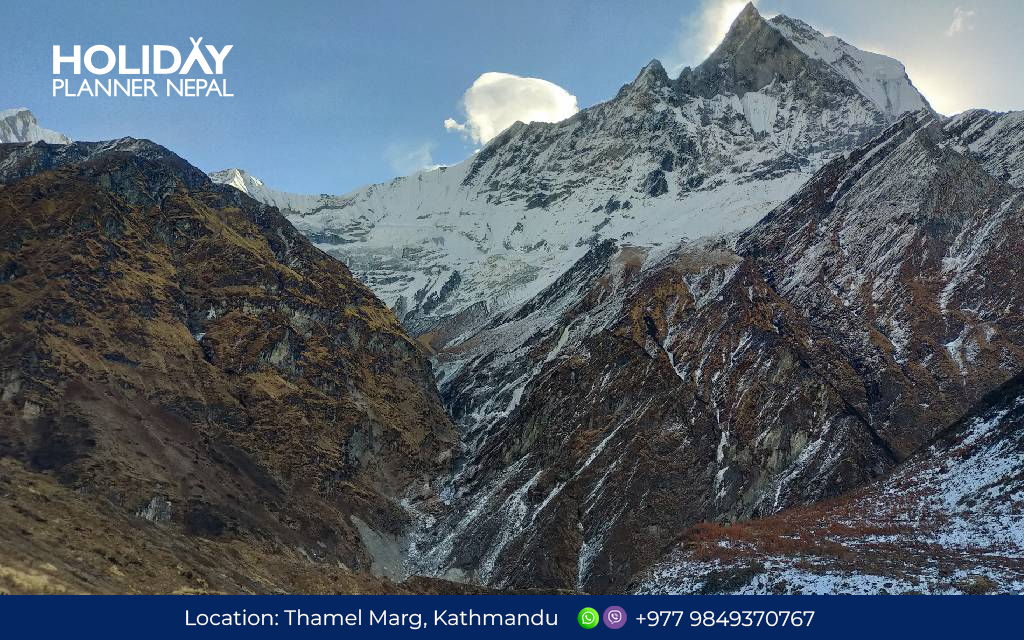
Toilet Facilities at Annapurna Base Camp
Depending on the individual lodging you are staying at, the Annapurna Base Camp may or may not include private and attached restroom facilities or may include squat or western toilets. Most guesthouses and luxury resorts feature contemporary restrooms with flushing toilets and running water.
The restrooms, however, might be more primitive, with pit latrines or squat toilets, in more rural locations or at inexpensive guesthouses.
When visiting the Annapurna Base Camp, it's a good idea to pack a variety of bathroom facilities because the area may need modern conveniences.
Bringing your toilet paper and hand sanitizer is also smart because these amenities might only sometimes be offered.
Generally, it's crucial to follow any regulations or norms when using restrooms in the Annapurna Region and to respect the local environment and culture.
Nearly most restrooms along the way are Western toilets, even though all teahouses may not have Western toilets (except Annapurna Base Camp), and we can buy toilet paper along the tea houses.
Electricity and internet facilities at Annapurna trail
Most Annapurna Trail offers solid electricity for charging, and the tea house charges around USD 3 to 7. Although most hotels charge between USD 1 and USD 5 for Internet and phone charging, some accommodations even offer free Wi-Fi internet. On the other side, the internet connection is only sometimes dependable.
However, SIM cards can be used to access the internet. The most economical way to connect to the internet is through SIM cards. Sim cards also offer a range of data bundles, lowering internet access costs. It is affordable. Sim cards can be easily acquired online, over the phone, or at airports. It needs to be bought with a passport. However, the connection might be less strong and easier to use than it is in base camp.
The two telecom companies that are active in the Annapurna Base Camp Trek are Ncell and NTC. Most rural areas and hiking trails have good cell phone reception. The network, however, might need to be more available in some places. The base camp is also included in this.
To help the Annapurna Base Ccamp Trail, a new GSM mobile tower has been built along the Mardi route. It is a solar-powered base station situated 3,550 meters above sea level (11,647 feet). There are plans for more development along the Annapurna Base Camp route. A reliable phone connection might soon be on the ABC Trekking Path.
Note that Holiday Tours Nepal provides a free SIM card on arrival, for which the activation charge and the data pack must be purchased, which will cost around 10 dollars maximum.

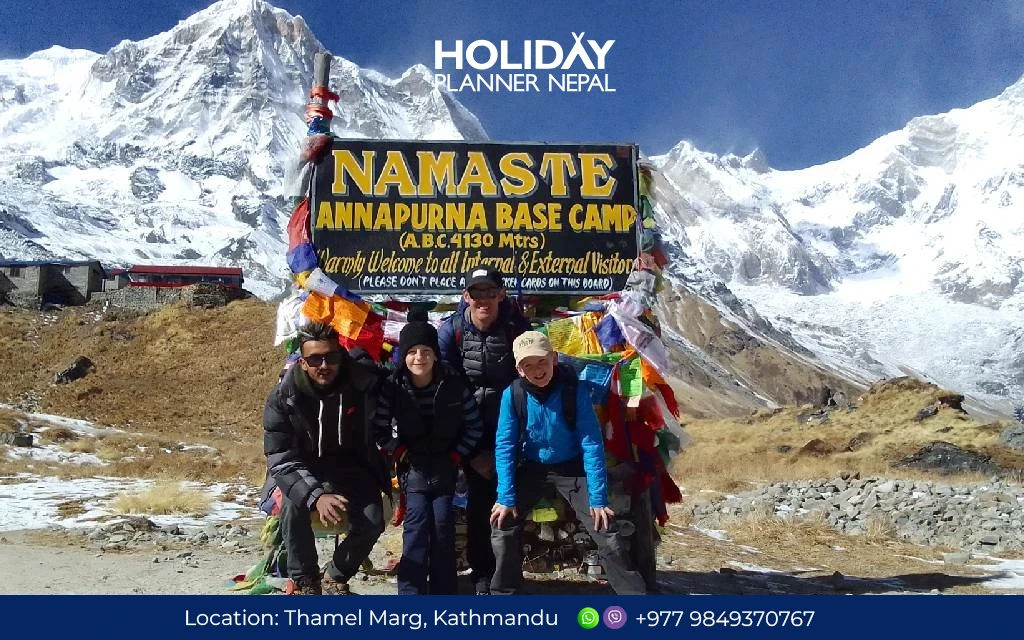
 General
General Upper Body
Upper Body Torso
Torso Lower Body
Lower Body Hands
Hands Feet
Feet Undergarments and Inner Wears
Undergarments and Inner Wears First Aid Kits and Medications
First Aid Kits and Medications Other Essentials
Other Essentials